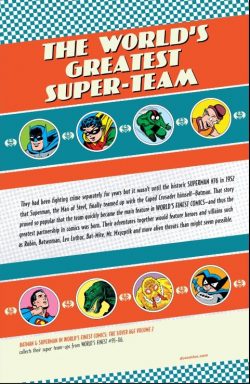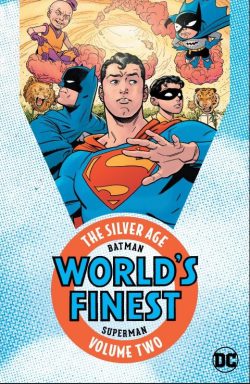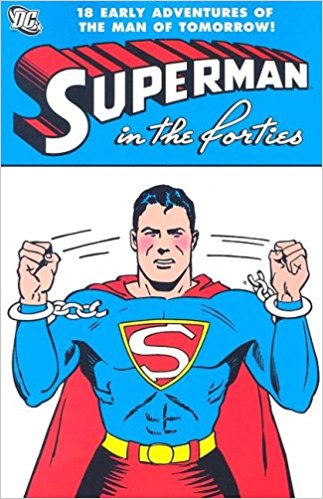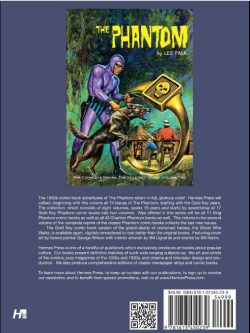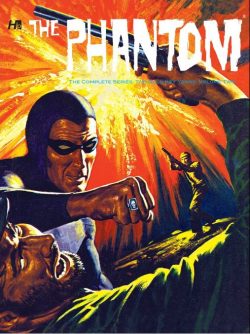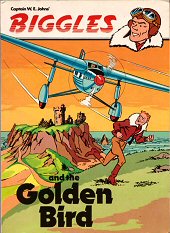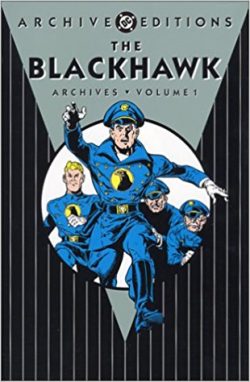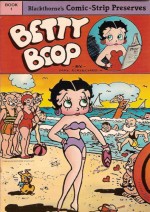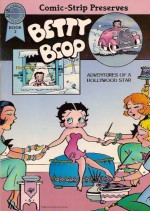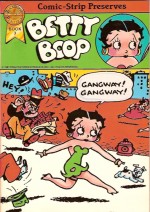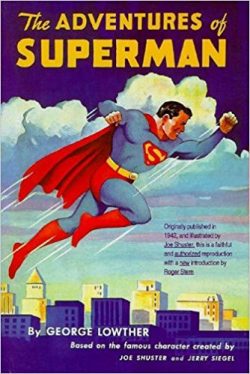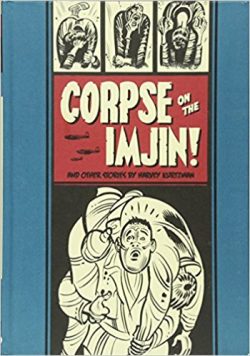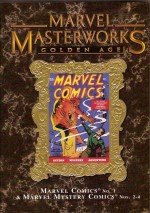
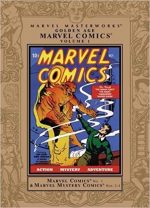
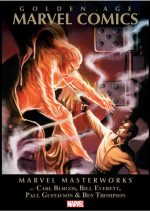
By Carl Burgos, Bill Everett, Paul Gustavson, Ben Thompson & others (Marvel)
ISBN: 978-0-7851-1609-7 (HB)Â Â Â Â Â Â Â Â Â Â Â Â Â Â Â Â Â Â Â 978-0-7851-5052-7 (TPB)
Die-hard fans craving a look at previously inaccessible vintage comics material have never had it so good. When I was young (not quite twenty minutes after the Golden Age actually ended), superhero and other genre stories from the dawn of the industry were all but impossible to find and a comprehensive scheme of reprinting old stuff a very low priority for even big publishers like DC and Marvel
These days a vast percentage of 1930, 1940s and 1950s comics output from many still-existing and bygone outfits is readily readable: either in expensive print compilations or more accessible digital editions.
DC led the way in the early 1990s, but soon after a great deal of Marvel Comics’ Timely and Atlas material joined the collective pool, and the notion that old stuff is not to modern tastes was finally disproved. For years accepted wisdom had decreed that most Golden Age stories were too dated and quite often painfully strident – maybe even offensive to 21st century eyes and sensibilities.
Nevertheless, many like me would rather have the raw historical form rather than any bowdlerised or censored reworking and even in their most jingoistic and populist excesses there are usually individual nuggets of gold amidst the shocking or – horror of horrors – badly crafted yarns from the art form’s sensationalistic antediluvian antecedents.
Marvel took quite some time before producing expensive deluxe volumes featuring their earliest comic adventures and this collection of the first four issues of the anthology title which started it all for Timely/Marvel/Red Circle/Atlas (before eventually and inevitably settling on Marvel Comics), despite re-presenting some of the most revered adventures of the Golden Age, clearly shows why.
Perhaps I’m being overly harsh and hyper-critical: I have to admit that there’s a lot of stuff here that I spent much of my early life lusting after. I am however a total comics nut with broad tastes and mutable standards. There are shameful horrors and truly pitiful examples of the medium lurking in my dusty comics boxes. I am not a new, casual or particularly discriminating punter.
Hi – my name is Win and I’m addicted to old comics…
After a rather shaky start and inauspicious in 1936, the fledgling comicbook industry was saved by the invention of Superman. His iconic innovation created a new popular genre and paved the way for explosive expansion.
By 1939 the new kids on the block were in a frantic flurry of creative frenzy with every publisher trying to make and own the Next Big Thing. Martin Goodman’s pulp fiction outfit leapt into the turbulent marketplace and scored big with their initial offering Marvel Comics: released late in the year before inexplicably switching to the marginally less euphonious Marvel Mystery Comics with the second issue.
During those early days, novel ideas, raw ambition and sheer exuberance could take you far and, as most alternative means of entertainment escapism for kids were severely limited, it just wasn’t that hard to make a go of it as a comicbook publisher. Combine that with a creative work-force which kept being drafted, and it’s clear to see why low and declining standards of story and art didn’t greatly affect month-to-month sales during the years of World War II.
However, once hostilities ceased a cascade-decline in super-hero strips began almost as soon as GI boots hit US soil again. Those innocent kids had seen a lot and wanted something more than brashness, naivety and breakneck pace from their funnybooks now…
Both the Human Torch and Sub-Mariner quickly won favour with the burgeoning, fickle readership, but the remaining characters were soon acknowledged to be B-listers and thus subject to immediate replacement once a better idea presented itself. Still, two out of seven was pretty good: Action and Detective Comics only had the one super-star apiece at the outset…
Another holdover from the pre-comics, pulp fiction phase of the company was a predilection to treat instalments as serial chapters; always promising more and better if you’d just come back next month…
Before the year was out Timely’s “Big Two†would clash; frequently and repeatedly battling like elemental gods in the skies above Manhattan…
Goodman apparently favoured Ka-Zar and The Angel: both characters that devolved from his own stable of pulp genre stars. Sadly, neither the generic jungle adventures of the company’s premiere Tarzan knockoff or the thud-and-blunder crimebusting rogue’s potboilers – which owed so much to Leslie Charteris’ iconic dark knight the Saint – just didn’t appeal to kids as much as the spectacular graphic histrionics of the anarchic Fire and Water anti-heroes…
An editorial policy of rapid expansion was quickly adopted: release a new book filled with whatever the art and script monkeys of the comics “shop†(freelance creative types who packaged material on spec for publishing houses: Martin Goodman bought all his product from Lloyd Jacquet’s Funnies Inc.) dreamed up, keep the popular hits and disregard everything else.
Timely Comics, or Red Circle as the company occasionally called itself, enjoyed a huge turnover of characters who only made one or two appearances before vanishing, never to be seen again until variously modern revivals or recreations produced new improved versions of characters such as Angel, Ka-Zar or Electro.
This volume – available in hardback, softcover and eBook editions – kicks into high gear following a knowledgeable and informative scene-setting introduction by Golden Age Guru Roy Thomas.
The landmark Marvel Comics #1 sported a cover by pulp illustrator Frank R. Paul, and after spot gag page ‘Now I’ll Tell One’ (by “Ed Wood†– AKA Fred Schwab) introduces to the gasping populace Carl Burgos’ landmark conception of ‘The Human Torch’…
The Fiery Fury led off a parade of wonderment, bursting into life as a malfunctioning humanoid devised by Professor Phineas Horton. Igniting into an uncontrollable blazing fireball whenever exposed to air, the artificial innocent was consigned to entombment in concrete but escaped to accidentally imperil the metropolis until it/he fell into the hands of a gangster named Sardo.
When the crook’s attempts to use the gullible android as a terror weapon dramatically backfire, the hapless newborn is left a misunderstood fugitive, like a modern-day Frankenstein’s monster. Even his creator only sees the humanoid as a means of making filthy money…
Crafted by Paul Gustavson, the opening episode of ‘The Angel’ owed a criminally large debt to the 1938 Louis Hayward film The Saint in New York. Although dressed like a superhero, the globe-trotting do-gooder offered a blending of Charteris’s iconic well-intentioned scoundrel and The Lone Wolf (Louis Vance’s urbane two-fisted hero who was the subject of 8 books and 24 B-movies between 1917 and 1949).
However, the four-colour paladin’s foes soon tended towards only the spooky, the ghoulish and the just plain demented….
He also seemed able to cast giant shadows in the shape of an angel. Not the greatest aid to cleaning up the scum of the Earth, but he seemed to manage in this initial enterprise where he is tasked with cleaning up New York’s gang problems before suffering the deadly depredations of the crime syndicate dubbed ‘the Six Big Men’…
Bill Everett’s ‘The Sub-Mariner’ was actually an expanded reprint of a beautiful black-&-white strip from Motion Picture Funnies. Prince Namor was the scion of an aquatic race living under the South Pole. These advanced mer-folk had been decimated by American mineral exploration a generation previously, and the Sub-Mariner’s mother Fen had been dispatched to spy upon the invaders. She had gotten too close, falling pregnant by one of the interlopers, and twenty years later her hybrid son was an amphibious mutant superman determined to exact revenge on the air-breathers – which he promptly began by attacking New York City…
Cowboy Jim Gardley was framed by ruthless cattle-baron Cal Brunder and found the only way to secure a measure of justice was to become ‘The Masked Raider’: dispensing six-gun law. Al Anders’ Lone Ranger riff was competent but uninspired, lasting until the 12th issue of Marvel Mystery.
Offering a complete adventure, ‘Jungle Terror’ by Tomm Dixon (aka Art Panajian) follows gentlemen explorers Ken Masters and Tim Roberts (visually patterned on Caniff’s Pat Ryan and Terry Lee) battling savages in the Amazon to find cursed diamonds, after which a brief prose vignette – a staple of early comics – recounted Ray Gill’s racing car drama of ‘Burning Rubber’ before the aforementioned ‘Adventures of Ka-Zar the Great’ saw Ben Thompson adroitly and serially adapt Bob Byrd’s pulp novel King of Fang and Claw to strip form.
In the first chapter, South African diamond miner John Rand and his wife crash their plane into the Belgian Congo where their son David grows up amidst jungle splendour to become brother to King of Lions Zar.
An idyllic life is only marred years later when murderous explorer Paul De Kraft kills old John, leaving young David to seek vengeance…
Behind a Charles J. Mazoujian Angel cover, the abruptly re-titled Marvel Mystery Comics #2 (December 1939) again offered ‘The Human Torch’ by Burgos, wherein the fiery fugitive has attained a degree of sophistication and control before stumbling onto a murderous racing car racket. Here gangster Blackie Ross ensures his drivers always win by strafing all other contestants from an airplane, until the big-hearted, outraged Torch steps in…
Gustavson then despatched ‘The Angel’ to Hong Kong to prevent museum researcher Jane Framan falling victim to a curse when the perils of the Lost Temple of Alano prove to be caused by greedy men, not magical spirits.
‘The Sub-Mariner’ himself is the threat in Everett’s second chapter, as the Marine Marvel goes berserk in a city powerhouse before showing his true colours by chivalrously saving a pretty girl caught in the ensuing conflagration.
Anders’ ‘Masked Raider’ then breaks up an entire lost town of outlaws, after which the debuting ‘American Ace’ (by Paul Lauretta and clearly based on Roy Crane’s soldier of fortune Wash Tubbs) finds Yankee aviator Perry Wade flying straight into danger when the woman who caused the Great War returns to start WWII by attacking innocent European nations with her hidden armies…
‘The Angel’ stars in an implausible, jingoistic prose yarn (by David C. Cooke illustrated by Mazoujian), single-handedly downing a strafing ‘Death-Bird Squadron’ before Thompson introduced fresh horrors – including a marauding, malicious ape named Chaka to plague young David in more ‘Adventures of Ka-Zar the Great’.
The issue closes with more gag pages: ‘All in Fun’ by Ed Wood and ‘Looney Laffs’ from Thompson.
Cover-dated January 1940 and sporting an Angel cover by Alex Schomburg, Marvel Mystery Comics #3) saw ‘The Human Torch’ slowly evolving into what we’d recognise as a superhero series as he battles a ruthless entrepreneur trying to secure the formula for a super-explosive that he can sell to Martian invaders, whilst ‘The Angel’ confronts a bloodthirsty death-cult sacrificing young women, even as ‘The Sub-Mariner’ takes a huge leap in dramatic quality after policewoman Betty Dean entices, entraps and successfully reasons with the intractably belligerent sub-sea invader.
With global war looming ever closer, opinions and themes were constantly shifting and Everett reacted brilliantly by turning Namor into a protector of all civilians at sea: spectacularly preying on any war-like nation sinking innocent shipping.
Naturally, even before America officially joined the fray, that meant primarily Nazis got their subs and destroyers demolished at the antihero’s sinewy hands…
When gold and oil are discovered under ranch land, ‘The Masked Raider’ steps in to stop greedy killers from driving off the settlers in a timeless tale of western justice, but current events overtook the ‘American Ace’, who faded out after this tale of Blitzkrieg bombings in a picturesque Ruritanian nation.
Even Cooke & Everett’s text thriller ‘Siegfried Suicide’ was naming and shaming the Axis directly in a yarn where a lone Yank saves some French soldiers from German atrocity, before neutrality resumes as, under African skies, the ‘Adventures of Ka-Zar the Great’ sees the boy hero rescue his animal friends from a well-meaning zoo hunter in a tale revealing hints of a Jungle Book style congress of animals…
The final inclusion in this volume – Marvel Mystery Comics #4, February 1940 – opens with a Schomburg cover depicting Sub-Mariner smashing a Nazi U-Boat before another inflammatory Burgos ‘Human Torch’ epic has the android create a secret identity as Jim Hammond and return to New York to clash with a criminal genius terrorising the city using warriors cloaked in deadly, sub-zero ‘Green Flame’…
‘The Angel’ too is back in the Big Apple, grappling with a small-time hood who manipulates a monstrous hyper-thyroid case named ‘Butch the Giant’. Impervious to pain and able to punch through brick walls his slavish meal ticket is eventually overcome, after which ‘The Sub-Mariner Goes to War’ when the passionate Prince returns to his Polar people to rally them and their advanced technology into a taskforce to enforce his Pax Namor upon the surface world’s assorted war mongers…
Even by its own low standards ‘The Masked Raider’ tale of claim-jumping is far from exemplary, but prose crime puzzler ‘Warning Enough’ (by Cooke & Harry Ramsey) is a genuinely enthralling change of pace tale.
Rendered by Steve Dahlman, ‘Electro, the Marvel of the Age’ introduces brilliant Professor Philo Zog who constructs an all-purpose wonder robot and forms an international secret society of undercover operatives who seek out uncanny crimes and great injustices for the automaton to fix. The first case involves retrieving a kidnapped child actress…
Another debut is ‘Ferret, Mystery Detective’ by Stockbridge Winslow (Bob Davis) & Irwin Hasen, following the eponymous crime-writer and his faithful assistants as they solve the case of a corpse dropped on the authors doorstep…
Proceedings then culminate with the increasingly impressive ‘Adventures of Ka-Zar the Great’ as the despised De Kraft returns to face the beginning (but not the end: that’s frustratingly left to the next issue and volume) of the jungle lord’s just vengeance…
Despite all the problems I’ve whinged about, I’m constantly delighted with this substantial chronicle, warts and all, but I can fully understand why anyone other than a life-long comics or Marvel fan might baulk at the steep price-tag in these days of grim austerity, with a wealth of better quality and more highly regarded comics collections available.
Nevertheless, value is one thing and worth another, and the sheer vibrantly ingenious rollercoaster rush and vitality of these tales, even more than any historical merit, is just so intoxicating that if you like this sort of thing you’ll love this sort of thing.
If anything could convince the undecided to take a look, later editions of this tome also include numerous tantalising house ads of the period and a full colour cover gallery of Marvel Mystery Comics‘ pulp predecessors: Marvel Science Stories, Marvel Tales, Marvel Stories, Ka-Zar, The Anger Detective, Uncanny Tales, Mystery Tales, Dynamic Science Stories and Star Detective Magazine by illustrators Norman Saunders, Frank R. Paul, H. W. Wesso and John W. Scott.
Upping the ante, further bonuses comprise the second print cover of Marvel Comics #1, a sample of Norman Saunders’ original painted art; Everett Sub-Mariner pages and unused cover roughs; a Mazoujian Angel pencilled cover reworked into the never-printed Zephyr Comics Ashcan cover and a Burgos watercolour sketch offering a partial redesign of the Human Torch.
Although probably not to the tastes of modern fans, for devotees of super-heroes, aficionados of historical works and true Marvel Zombies there’s still lots to offer here.
As always, in the end, it’s up to you…
© 1939, 1940, 2004, 2017 Marvel Characters, Inc. All rights reserved.
